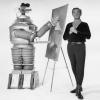|
B-9 ROBOT PHOTO GALLERY #07 |
Updated: November 19, 2023



































































































A robot is a mechanical or virtual intelligent agent that can perform tasks automatically or with guidance, typically by remote control. In practice a robot is usually an electro-mechanical machine that is guided by computer and electronic programming.
robots can be autonomous, semi-autonomous or remotely controlled. Robots range from humanoids such as Asimo and Topio to Nano
robots, Swarm robots, Industrial robots, military robots, mobile and servicing robots. By mimicking a lifelike appearance or automating movements, a robot may convey a sense that it has intent or agency of its own. The branch of technology that deals with robots is robotics.
When societies first began developing, nearly all production and effort was the result of human labour, as well as with the aid of semi- and fully domesticated animals. As mechanical means of performing functions were discovered, and mechanics and complex mechanisms were developed, the need for human labour was reduced. Machinery was initially used for repetitive functions, such as lifting water and grinding grain. With technological advances more complex machines were slowly developed, such as those invented
by Hero of Alexandria ( in Egypt ) in the 1st century AD, and the first half of the second millennium AD, such as the Automata of
Al-Jazari in the 12th century AD ( in medieval Iraq ). They were not widely adopted as human labor, particularly slave labor, was still inexpensive compared to the capital-intensive machines. Men such as Leonardo Da Vinci in 1495 through to Jacques de Vaucanson in 1739, as well as rediscovering the Greek engineering methods, have made plans for and built automata and robots leading to books of designs such as the Japanese Karakuri zui ( Illustrated Machinery ) in 1796. As mechanical techniques developed through the Industrial age we find more practical applications such as Nikola Tesla in 1898, who designed a radio-controlled boat, and John Hammond Jr. and Benjamin Miessner who in 1912 created the Electric Dog as a precursor to their self directing torpedo of 1915. We also find a more android development as designers tried to mimic more human-like features including designs such as those of biologist Makoto Nishimura in 1929 and his creation Gakutensoku, which cried and changed its facial expressions, and the more crude Elektro from Westinghouse Electric Corporation in 1938.
Electronics then became the driving force of development instead of mechanics, with the advent of the first electronic autonomous robots created by William Grey Walter in Bristol, England, in 1948. The first digital and programmable robot was invented by
George Devol in 1954 and was ultimately called the Unimate. Devol sold the first Unimate to General Motors in 1961 where it was
used to lift pieces of hot metal from die casting machines at the Inland Fisher Guide Plant in the West Trenton section of Ewing Township, New Jersey. Since then we have seen robots finally reach a more true assimilation of all technologies to produce robots such as Asimo which can walk and move like a human. Robots have replaced humans in the assistance of performing those repetitive
and dangerous tasks which humans prefer not to do, or are unable to do due to size limitations, or even those such as in outer
space or at the bottom of the sea where humans could not survive the extreme environments.
Man has developed an awareness of the problems associated with autonomous robots and how they may act in society. Fear of robot behaviour, such as Shelley's Frankenstein and the EATR, drive current practice in establishing what autonomy a robot should and should not be capable of. Thinking has developed through discussion of robot control and artificial intelligence ( AI ) and how
its application should benefit society, such as those based around Asimov's three laws. Practicality still drives development forwards and robots are used in an increasingly wide variety of tasks such as vacuuming floors, mowing lawns, cleaning drains, investigating other planets, building cars, in entertainment and in warfare.
|
 HOME
HOME
 About
About
 EMail Me
EMail Me TOP |
TOP |  PREVIOUS ITEM | NEXT ITEM
PREVIOUS ITEM | NEXT ITEM  ( 119 of 244 )
( 119 of 244 )



































































































